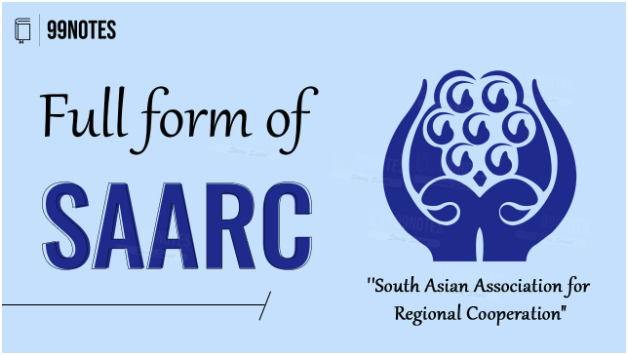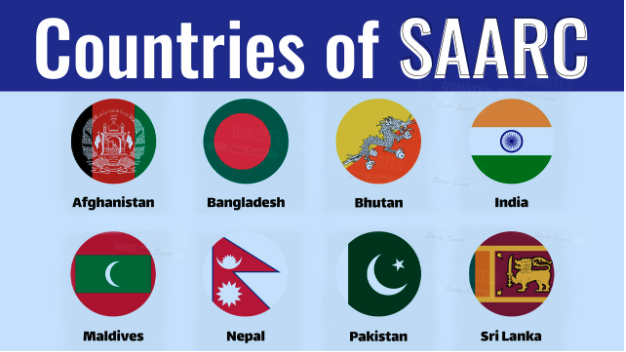SAARC Full Form: Members, Primary Organs, Advantages & Challenges
What is SAARC full form?

The SAARC full form is “South Asian Association for Regional Cooperation.” It is a geopolitical and economic organisation comprising eight South Asian nations founded in 1985. The SAARC headquarters is in Kathmandu, Nepal.
SAARC’s eight member countries are as follows:
- India
- Bangladesh
- Bhutan
- Afghanistan
- Sri Lanka
- Maldives
- Nepal
- Pakistan
SAARC Observer countries:
- European Union
- China
- Iran
- The Republic of Korea
- Australia
- Japan
- Mauritius
- Myanmar
- United States of America
About SAARC

In the late 1970s, the seven South Asian countries of India, Bangladesh, Nepal, Sri Lanka, Bhutan, the Maldives, Pakistan, and Afghanistan agreed to form a trade bloc to provide a forum for South Asian citizens to function in the spirit of friendship, confidence, and understanding.
- On May 2, 1980, Zia Ur Rahaman launched an attempt to form a trade bloc. On December 8, 1985, the inaugural summit was convened in Dhaka.
- Afghanistan became the eighth member of SAARC in 2007.
- India was the Chair of SAARC in 2007, and it was the most productive year in the organisation’s history.
SAARC’s Cooperation Areas
SAARC nations have pledged to cooperate in the following areas:
- Agriculture Customs Cooperation Disaster Management
- Economic issues
- Finance for Environmental Protection
- Fisheries
- Population and Health
- Human Capital Development
- ICT
- Control of Narcotics
- Development of Rural Areas
- Technology and Science
- Social Concerns
- Terrorism
- Tourism Trade Transport.
SAARC’s primary organs
1. State or Government Head Meetings
This is the highest decision–making forum, and it meets every two years. The most recent meeting took place in Kathmandu, Nepal, in 2024.
2. Council of Ministers
This is the second highest decision-making body and meets once a year.
3. The SAARC Secretariat
It is situated in Kathmandu and is in charge of the organisation’s day-to-day operations.
4. Regional Cooperation Forums
There are a variety of sectoral ministerial forums that gather annually to discuss specific concerns.
5. Associate Members
The Maldives, Bhutan, Bangladesh, and Sri Lanka.
Advantages of SAARC
SAARC has several advantages:
It has helped to develop bridges and foster deeper links between South Asian countries. It has contributed to the improvement of South Asian Infrastructure through initiatives such as the SAARC Development Fund.
It has made South Asian collaboration on topics such as terrorism and climate change possible.
Challenges for SAARC
SAARC confronts several challenges:
- South Asia is a diverse region, which might make collaboration challenging.
- South Asian Countries have varying levels of economic development, which can cause friction.
- South Asia has a variety of unsolved problems that might stymie collaboration.
- SAARC has been impeded by the South Asian Leader’s lack of political will. Despite the hurdles, SAARC has been effective in boosting South Asian regional cooperation. South Asian nations are hoping to work together to tackle these issues and enhance SAARC.
- SAARC is a regional cooperation model. SAARC, which was founded in 1985, has effectively encouraged economic integration and growth among its member countries.
FAQ’s Related to SAARC full form
What are the countries in SAARC?
Afghanistan, Bangladesh, Bhutan, India, Maldives, Nepal, Pakistan and Sri Lanka are its members. As of 2023, SAARC accounts for 3% of the global surface area, 21% of the global population, and 5.21% of the worldwide GDP.
On December 8, 1985, the heads of State or Government of India, Bangladesh, Maldives, Bhutan, Nepal, Sri Lanka and Pakistan formally accepted the charter of the South Asian Association for Regional Cooperation.
India was one of the founding members of SAARC(South Asian Association for Regional Cooperation). It joined SAARC in December 1985.
SAARC full form is “South Asian Association for Regional Cooperation.
Other Related Links:
| Full Form | UNESCO Full form |
| ASEAN full form | WHO Full form | UNICEF Full Form | IMF Full form |
| CRZ Full Form | BRICS Full Form |
| COP Full Form | UPSC Notes |

